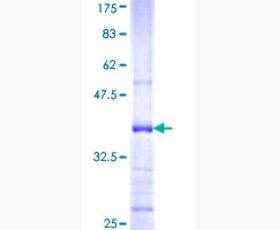Recombinant Human Protein N-terminal Glutamine Amidohydrolase/NTAQ1
| Product name: | Recombinant Human Protein N-terminal Glutamine Amidohydrolase/NTAQ1 |
| Source: | E.coli |
| Purity: | Greater than 95% as determined by reducing SDS-PAGE. |
| Buffer Formulation: | Supplied as a 0.2 μm filtered solution of PBS,100mM GSH,1% TritonX-100,15% glycerol,pH7.4. |
| Applications: | Applications:SDS-PAGE; WB; ELISA; IP. |
| Storage: | Avoid repeated freeze/thaw cycles. Store at 2-8 oC for one month. Aliquot and store at -80 oC for 12 months. |
| UOM: | 100ug/50ug/200ug/1mg/1g |
| Source | E.coli |
| Description | Recombinant Human NTAQ1 is produced by our E.coli expression system and the target gene encoding Met1-Cys205 is expressed with a GST tag at the N-terminus. |
| Names | Protein N-terminal glutamine amidohydrolase,WDYHV1,Protein NH2-terminal glutamine deamidase,N-terminal Gln amidase,Nt(Q)-amidase,C8orf32, NTAQ1, REF: C1009 |
| Accession # | Q96HA8 |
| Formulation | Supplied as a 0.2 μm filtered solution of PBS,100mM GSH,1% TritonX-100,15% glycerol,pH7.4. |
| Shipping |
The product is shipped on dry ice/ice packs. |
| Storage |
Store at < -20°C, stable for 6 months after receipt. Please minimize freeze-thaw cycles. |
| Purity |
Greater than 95% as determined by reducing SDS-PAGE. |
| Endotoxin | Less than 0.1 ng/µg (1 IEU/µg) as determined by LAL test. |
| Amino Acid Sequence |
MSPILGYWKIKGLVQPTRLLLEYLEEKYEEHLYERDEGDKWRNKKFELGLEFPNLPYYIDGDVKL TQSMAIIRYIADKHNMLGGCPKERAEISMLEGAVLDIRYGVSRIAYSKDFETLKVDFLSKLPEML KMFEDRLCHKTYLNGDHVTHPDFMLYDALDVVLYMDPMCLDAFPKLVCFKKRIEAIPQIDKYLKS SKYIAWPLQGWQATFGGGDHPPKSDLVPRGSMEGNGPAAVHYQPASPPRDACVYSSCYCEENVWK LCEYIKNHDQYPLEECYAVFISNERKMIPIWKQQARPGDGPVIWDYHVVLLHVSSGGQSFIYDLD TVLPFPCLFDTYVEDAIKSDDDIHPQFRRKFRVICADSYLKNFASDRSHMKDSSGNWREPPPPYP CIETGDSKMNLNDFISMDPKVGWGAVYTLSEFTHRFGSKNC
|
| Background | Human protein N-terminal glutamine amidohydrolase (WDYHV1) is an enzyme that in humans is encoded by the WDYHV1 gene, belongs to the NTAQ1 family.WDYHV1 mediates the side-chain deamidation of N-terminal glutamine residues to glutamate, which is an important step in N-end rule pathway of protein degradation. Conversion of the resulting N-terminal glutamine to glutamate renders the protein susceptible to arginylation, polyubiquitination and degradation as specified by the N-end rule. However,it does not act on substrates with internal or C-terminal glutamine andnon-glutamine residues in any position. With the exception of proline, all tested second-position residues on substrate peptides do not greatly influence the activity. In contrast, a proline at position 2, virtually abolishes deamidation of N-terminal glutamine. |














